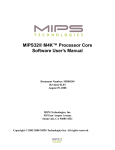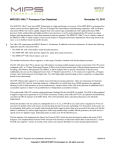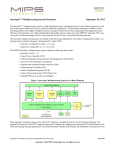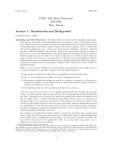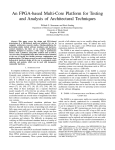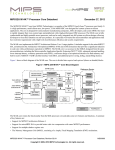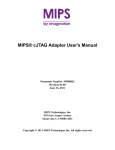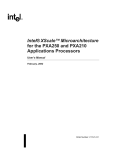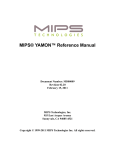Download MIPS32® 74Kc™ Processor Core Datasheet
Transcript
MIPS
Verified
MIPS32® 74Kc™ Processor Core Datasheet
™
June 03, 2011
The MIPS32® 74Kc™ core from MIPS Technologies is a high-performance, low-power, 32-bit RISC Superscalar
core designed for custom system-on-chip (SoC) applications. The core is designed for semiconductor manufacturing
companies, ASIC developers, and system OEMs who want to rapidly integrate their own custom logic and peripherals with a high-performance RISC processor. Fully synthesizable and highly portable across processes, it can be easily integrated into full SoC designs, allowing developers to focus their attention on end-user products.
The 74Kc core implements the MIPS32 Release 2 Architecture in a superscalar, out-of-order execution pipeline. The
deeply pipelined core can support a peak issue and graduation rate of 2 instructions per cycle. The 74Kc core also
implements the MIPS DSP ASE - Revision 2.0, which provides support for signal processing instructions, and
includes support for the MIPS16e™ ASE and the 32-bit privileged resource architecture. This architecture is supported by a wide range of industry-standard tools and development systems.
The 74Kc core has a Level-1 (L1) Instruction Cache, which is configurable at 0, 16, 32, or 64 KB in size. It is organized as 4-way set associative. Up to four instruction cache misses can be outstanding. The instruction cache is virtually indexed and physically tagged to make the data access independent of virtual to physical address translation.
Instruction cache tag and data access are staggered across 2 cycles, with up to 4 instructions fetched per cycle.
The superscalar 74Kc core can dispatch up to 2 instructions per cycle into one of the arithmetic-logic unit (ALU) or
address generation (AGEN) pipes. The AGEN pipe executes all Load/Store and Control Transfer instructions while
the ALU pipe executes all other instructions. Instructions are issued and executed out-of-order; however, the results
are buffered and the architectural state of up to 2 instructions per cycle is updated in program order.
The L1 Data Cache is configurable at 0, 16, 32, or 64 KB in size. It is organized as 4-way set associative. Data cache
misses are non-blocking and up to four may be outstanding. The data cache is virtually indexed and physically tagged
to make the data access independent of virtual-to-physical address translation. The tag array also has a virtual address
portion, which is used to compare against the virtual address being accessed and generate a data cache hit prediction.
This virtual address hit prediction is always backed up by a comparison of the translated physical address against the
physical tag. To achieve high frequencies while using commercially available SRAM generators, the cache access
and hit determination is spread across three pipeline stages, dedicating an entire cycle for the SRAM access.
The synthesizable 74Kc core includes a high performance Multiply/Divide Unit (MDU). The MDU is fully pipelined
to support a single cycle repeat rate for 32×32 MAC instructions. The CorExtend® block can utilize the accumulator
registers in the MDU block, allowing specialized functions to be efficiently implemented.
The MIPS DSP ASE - Revision 2.0 provides support for a number of powerful data processing operations. There are
instructions for fractional arithmetic (Q15/Q31) and for saturating arithmetic. Additionally, for smaller data sizes,
SIMD operations are supported, allowing 2×16 bit or 4×8 bit operations to occur simultaneously. Another feature of
the ASE is the inclusion of additional HI/LO accumulator registers to improve the parallelization of independent
accumulation routines. All 32-bit operand arithmetic DSP instructions (except multiply) are executed in the ALU
pipe while the 64-bit operand arithmetic and multiply class DSP instructions are executed in the MDU pipe.
The Bus Interface Unit (BIU) implements the Open Core Protocol (OCP), which has been developed to address the
needs of SoC designers. This implementation features 64-bit read and write data buses to efficiently transfer data to
and from the L1 caches. The BIU also supports a variety of core/bus clock ratios to give greater flexibility for system
design implementations.
MIPS32® 74Kc™ Processor Core Datasheet, Revision 01.07
Copyright © 2006-2011 MIPS Technologies Inc. All rights reserved.
MD00496
Optional support for external Instruction and Data
Scratchpad RAM arrays, with reference design supporting DMA interfaces for loading the arrays.
data virtual address/value breakpoints. Additionally, real-time tracing of instruction program
counter, data address and data values can be supported.
An Enhanced JTAG (EJTAG) block allows for software debugging of the processor, and includes a
TAP controller as well as optional instruction and
Figure 1
Figure 1 shows a block diagram of the 74Kc core.
74Kc™ Core Block Diagram
OCP Interface
On-Chip Bus(es)
Bus Interface Unit (BIU)
4-entry write buffer,
8 outstanding reads
I-Cache 0-64 KB
Instruction Fetch Unit
(IFU)
4-way set associative
ISPRAM
Interface
Memory Management
Unit (MMU)
16-64 entry JTLB or FMT
Instruction Scratchpad
Instruction Scratchpad
RAM (ISPRAM)
4KB - 1MB
Instruction
Decode/Dispatch
Unit (IDU)
D-cache 0-64 KB
4-way set associative
ALU PIPE
AGEN PIPE
Load/Store Unit (LSU)
Integer Execution Unit
(IEU)
CorExtend
Interface
Non-blocking
4 outstanding misses
Multiply/Divide Unit
(MDU)
CorExtend
Graduation Unit (GRU)
Data Scratchpad
RAM (DSPRAM)
DSPRAM
4 KB - 1 MB
Interface
System Coprocessor
EJTAG
Power Management
Debug
Off-chip
Interface
TAP
Trace
Fixed/Required
2
Optional
Off/On-chip
Trace I/F
MIPS32® 74Kc™ Processor Core Datasheet, Revision 01.07
Copyright © 2006-2011 MIPS Technologies Inc. All rights reserved.
74Kc™ Core Features
•
14-stage ALU and 15-stage AGEN pipelines
•
12-stage ALU fetch and execution pipe
•
13-stage AGEN fetch and execution pipe
•
Common 2-stage graduation pipe
•
32-bit address paths
•
128-bit data path for instruction cache and 64
or 128-bit data path for data cache
•
•
64-bit data paths to external interface
•
MIPS32 Release2 Instruction Set and Privileged Resource Architecture
•
MIPS16e Code Compression
•
MIPS DSP ASE - Revision 2.0
•
•
3 additional pairs of accumulator registers
•
Fractional data types (Q15, Q31)
•
Saturating arithmetic
•
SIMD instructions operate on 2×16 bit or
4×8 bit simultaneously
AGEN pipe executes load/store and control transfer instructions
•
ALU pipe executes all other instructions
•
32 (18 ALU, 14 AGEN) completion buffers hold execution results until instructions
are graduated in program order
Programmable Memory Management Unit
•
16/32/48/64 dual-entry, dual-ported TLB
shared by Instruction and Data MMU
•
4-entry ITLB (4KB, 16KB page size)
•
4K, 16K, 64K, 256K, 1M, 4M, 16M, 64M,
256M byte page size supported in JTLB
•
Optional simple Fixed Mapping Translation (FMT) mechanism
Programmable L1 Cache Sizes
•
Individually configurable instruction and
data caches
•
Instruction Cache sizes of 0/16/32/64 KB
•
Data Cache sizes of 0/16/32/64 KB
•
4-way set associative
•
32-byte cache line size
•
Virtually indexed, physically tagged
•
Cache line locking support
•
Up to 4 outstanding I-cache misses
•
Virtual tag based hit prediction in data
cache
•
Up to 4 unique outstanding D-cache line
misses and 9 total load misses
•
Writeback and write-through support in
data cache
•
Non-blocking data cache prefetches
Instruction Fetch Unit
•
•
•
•
•
•
•
•
4-instruction fetch per cycle
8-entry Return Prediction Stack
Combined Majority Branch Predictor
using three 256-entry Branch History
Tables (BHT).
64-entry (4-way associative) jump register
cache to predict target for indirect jumps.
Hardware prefetching of the next 1 or 2
sequential cache lines on a miss. Number
of prefetched lines (0, 1, or 2) controllable
via configuration bits.
Dual Out-of-Order Instruction Issue
•
Separate ALU and AGEN pipes
MIPS32® 74Kc™ Processor Core Datasheet, Revision 01.07
Copyright © 2006-2011 MIPS Technologies Inc. All rights reserved.
3
•
•
•
•
Optional parity support
•
Scratchpad RAM support
•
Independent Instruction and Data Scratchpad RAMs
•
Scratchpad RAM size from 4KB to 1MB
•
Independent of cache configuration
•
64-bit OCP interfaces for external DMA
•
OCP port runs at the same core/bus clock
ratio as the BIU interface
Front-side L2 support
•
Support for inline L2 cache.
•
L2 cache can be configured to be bypassable.
•
OCP version 2.1 interface with 32-bit
address and 64-bit data
•
OCP version 2.1 interface runs at core/bus
clock ratios of 1, 1.5, 2, 2.5, 3, 3.5, 4, 5, or
10 via a separate synchronous bus clock
•
Clock ratio can be changed dynamically
•
Burst size of four, 64-bit beats
•
4-entry write buffer
•
“Simple” byte enable mode allows easier
bridging to other bus standards
•
Extensions for front-side L2 cache
•
Allows user to define and add instructions
to the core at build time
•
Maintains full MIPS32® compatibility
•
Includes access to GPRs and Accumulator
registers
•
Instruction operand format (source/destination registers) and latency specified by a
programmable template
•
Allows latencies of 3, 5, or >5 cycles when
destination is a GPR/Accumulator. Singlecycle latency is allowed when there is no
modification to the architectural state of
the 74Kc core.
•
Allows in-order issue of CorExtend
instructions that do not modify the 74Kc
core architectural state
•
Supported by industry-standard development tools
Maximum issue rate of one 32×32 multiply per clock
Relocatable Reset Vector
•
Multiply/Divide Unit
•
4
•
Bus Interface
•
•
CorExtend® User Defined Instruction Set
Extensions
•
Support for user (pin) programmable reset
vector in a multi-core environment.
Power Control
•
Minimum frequency: 0 MHz
•
Power-down mode (triggered by WAIT
instruction)
•
Support for software-controlled clock
divider
•
Support for top-level, block-level, finegrained and data cache clock gating
EJTAG Debug 5.0
•
7-cycle multiply latency
•
Support for single-stepping
•
Iterative SRT divide algorithm. Minimum
10 and maximum 50 clock latency (dividend (rs) sign extension-dependent)
•
Instruction address and data address/value
breakpoints
•
TAP controller is chainable for multi-CPU
debug
MIPS32® 74Kc™ Processor Core Datasheet, Revision 01.07
Copyright © 2006-2011 MIPS Technologies Inc. All rights reserved.
•
•
Cross-CPU breakpoint support
•
Relocatable debug handler
•
•
Testability
MIPS Trace
•
PC, data address, data value, performance
counter value, processor pipeline inefficiency tracing with trace compression
•
PDtrace version 6 compliant
•
Full scan design achieves test coverage in
excess of 99% (dependent on library and
configuration options)
•
Optional memory BIST for internal
SRAM arrays
Support for on-chip and off-chip trace
memory
Pipeline Flow
The 74Kc core implements a 14/15-stage pipeline.
Three extra fetch stages are conditionally added
when executing MIPS16e instructions. This pipe-
line allows the processor to achieve a high frequency while maintaining optimal area and power
numbers. Figure 2 shows the 74Kc core pipeline.
Figure 2 74Kc™ Core Pipeline
MDU
ALU
AF
IFU
MB
M1
ID
IS
IB
DD
DR
DS
M4
ALU
AM
GRU
IR
IK
WB GC
AB
DM
AGEN
AGEN
IFU
Added Stages
for MIPS 16eTM
mode
M3
IDU
AC
IT
M2
IX
Instruction Fetch Unit (IFU)
EM
EA
EC
ES
EB
•
Tag compare, Detect I-cache hit
IT: Instruction Tag Read
IS: Instruction Select
•
I-cache tag arrays accessed
•
Way select
•
Branch History Table, JRC accessed
•
Target calculation start
•
ITLB address translation performed
IB: Instruction Buffer
•
Instruction watch and EJTAG break compares
done
•
Instruction Buffer write
•
Target calculation done
ID: Instruction Data Read
IR: Instruction Recode
•
I-cache data array accesses
•
MIPS16e instruction recode
MIPS32® 74Kc™ Processor Core Datasheet, Revision 01.07
Copyright © 2006-2011 MIPS Technologies Inc. All rights reserved.
5
IK: Instruction Decode
•
MIPS16e branch decode
•
MIPS16e target validate
IX: Instruction Expansion
•
MIPS16e macro expansion
•
Integer Execution Unit (IEU)
AF: ALU Register file Read
•
Instruction Decode and Dispatch Unit
(IDU)
Access Rename Map, get source register availability to resolve source dependency
•
Decode instructions and assign pipe and
instruction identifier
•
Check execution resources
Update Rename Map at destination register to
resolve output dependency
Select source operands and set up for execution
AC: ALU Compute
•
Integer Execution start. Logical operations,
some shift and arithmetic operations complete
and bypass the results.
•
Complete Integer Execution and bypass results
EM: AGEN Operand Mux
•
Send instruction information to Graduation
Unit (GRU)
•
•
Send instruction to Decode and Dispatch
Queue (DDQ)
EA: AGEN Effective Address Compute
DS: Select for Dispatch
6
•
AB: ALU Results Bypass
DR: Rename
•
AGEN pipe will complete reading source operands from Register File and Completion Buffers.
AM: ALU Operand Mux
DD: Decode
•
AGEN pipe will starting reading source operands from Register File and Completion Buffers.
•
Check for operand and resource availability
and mark valid instructions as ready for dispatch
•
Select 1 out of 8 (6-entry DDQ + 2 staging registers) ready instructions in each ALU and
AGEN pipe independently
Select source operands for Load/Store index
computation and set up for execution
•
Compute Effective Address for Load/Store
instructions
•
Select source operands for Store data and
Branch/Jump instructions
•
Start JTLB access
Load/Store Unit (LSU)
DM: Instruction Mux
EC: Cache Access
•
•
Access D-cache and D-tag arrays. Read Virtual
and Physical tags along with data
•
Continue JTLB access
•
AGEN pipe resolves conditional branch and
Jump instruction
Read out the selected instruction from the previous stage and update the selection information
•
Generate controls for source-operand bypass
mux
•
ALU pipe will start premuxing operands based
on the selected instruction.
MIPS32® 74Kc™ Processor Core Datasheet, Revision 01.07
Copyright © 2006-2011 MIPS Technologies Inc. All rights reserved.
ES: D-Cache way select
•
Select D-cache way based on Virtual tag match
with Effective Address
•
Start Physical Tag compare with JTLB data
•
AGEN pipe redirects IFU in the event of
branch mis-predict or register indirect jump
•
Write execution results into ALU and AGEN
completion buffers
•
Update all GRU structures to indicate instruction completion
•
Oldest 2 entries that have completed execution
are identified and their addresses are obtained
to read the completion buffers and associated
information to graduate 2 instructions
EB: Cache Data Bypass
•
Complete data selection and align load data
•
Bypass results (selected data) to both AGEN
and ALU pipes
•
Validate Virtual tag match with Physical tag
comparison
Graduation Unit (GRU)
GC: Graduation Complete
•
Two instructions are graduated and Register
File data is obtained for update
•
Load misses are graduated with their destination marked unavailable
•
Load misses and Stores (hits and misses) are
activated in the LSU for further processing
WB: Writeback
•
Consolidate and propagate D-cache hit/miss
information
74Kc™ Core Logic Blocks
The 74Kc core consists of the logic blocks defined
in the following subsections (see Figure 1).
Instruction Fetch Unit (IFU)
The Instruction Fetch Unit (IFU) is responsible for
fetching instructions from the Instruction Cache,
Instruction Scratchpad or Memory and feeding
them to the execution units. The IFU can fetch up to
4 instructions at a time from an aligned PC. The
IFU uses majority branch prediction based on a
gshare predictor. There are three, 256-entry Branch
History Tables that are indexed by different combinations of instruction PC and Global History. The
majority of these 3 predictions are used to determine the predicted direction of a conditional
branch. The IFU also has an 8-entry Return Prediction Stack to predict subroutine return addresses
and a 64-entry jump indirect target address predictor. A 4-way, 16-entry/way buffer learns and predicts the target addresses for indirect jumps.
The IFU has a 4-entry microTLB which is used to
translate the virtual address into the physical
address. This translated physical address is used to
compare against tags in the instruction cache to
determine a hit.
The functionality of the IFU is spread across 4 corevisible pipeline stages in MIPS32 mode. Additional
stages are in the shadow of execution and do not
account for the minimum recirculation path in the
event of a PC redirection. In the MIPS16e™ mode,
the IFU takes an additional 3 stages to recode and
expand the compressed code.
There is a 12-entry Instruction Buffer to decouple
the instruction fetch from execution. Up to 4
instructions can be written into this buffer, but a
maximum of 2 instructions can be read from this
buffer by the IDU.
The IFU can also be configured to allow for hardware prefetching of cache lines on a miss. When an
instruction cache miss is detected, the IFU can
prefetch the next 0, 1, or 2 lines (besides the missed
line) to reduce average miss latency. The number of
prefetched lines can be configured by software via
Config7 register settings.
MIPS32® 74Kc™ Processor Core Datasheet, Revision 01.07
Copyright © 2006-2011 MIPS Technologies Inc. All rights reserved.
7
MIPS16e™ Application-Specific
Extension
The 74Kc core includes support for the MIPS16e
ASE. This ASE improves code density by using 16bit encoding of many MIPS32 instructions plus
some MIPS16e-specific instructions. PC-relative
loads allow quick access to constants. SAVE/
RESTORE macro instructions provide for singleinstruction stack frame set-up/teardown for efficient
subroutine entry/exit.
Instruction Decode and Dispatch Unit
(IDU)
This unit is responsible for receiving instructions
from the IFU and dispatching them to the execution
units when their operands and required resources
are available. Up to two instructions can be received
in-order from the IFU per cycle. The instructions
are assigned an instruction ID and a completion
buffer ID, which identifies a buffer location to hold
results temporarily. The instruction is also renamed
by looking up in a Rename Map, and the source
registers are replaced (if necessary) by completion
buffer IDs of producer instructions, so that operands may be bypassed as soon as possible.
Execution Units
The 74Kc core execution unit implements two
pipes: an ALU pipe for handling all arithmetic
operations (logical, shift, add, subtract) and an
AGEN pipe for handling all load/store operations
and control transfer instructions and an autonomous
multiply/divide unit (MDU) and CorExtend unit.
The MDU and CorExtend pipe share control logic
with the ALU pipe. There is a 31-entry, 32-bit register file that is shared by both the pipes. There is a
separate 18-entry, 64-bit completion buffer for the
ALU pipe, and a 14-entry, 32 bit completion buffer
for the AGEN pipe.
ALU Pipe
The ALU pipe spans four stages as follows:
•
The first two stages (AF, AM) of the ALU pipe
are used to prepare operands, read the register
file and completion buffer, and mux select all
operands for the arithmetic operation.
•
Execution is performed in the AC stage, which
includes:
Renamed instructions are assigned to one of two
pipes (ALU or AGEN) and written into the Decode
and Dispatch Queue (DDQ). The oldest instruction
that has all the operands ready and meets all
resource requirements is dispatched independently
to the corresponding pipe. It is possible that instructions will be dispatched out-of-order relative to program order. Dispatched instructions do not stall in
the pipe and write the results into the completion
buffer.
•
Arithmetic Logic Unit (ALU) for performing arithmetic and bitwise logical operations
•
Shifter
•
Leading Zero/One detect unit for implementing the CLZ and CLO instructions
•
All logical operations, some arithmetic
operations {ADD (rt=0), ADDU (rt=0),
LUI, SEH, SEB, ZEH, ZEB, SLT, SLTI,
SLTIU, SLTU, SLL (shift<=8) and SRL
(31<=shift<=25)} will complete and
bypass the results from AC stage to both
ALU and AGEN pipe consumers.
•
ADD, ADDU, ADDI, ADDIU instructions
can bypass the results in AC to the consumers in the ALU pipe. If the consumer
instructions are in the AGEN pipe, these
instructions will bypass the results from
the AB stage.
The IDU also keeps track of the progress of the
instruction through the pipe, updating the availability of operands in the Rename Map and in all
dependent instructions in the DDQ.
The IDU also writes the instruction ID, completion
buffer ID, and related information into structures in
the Graduation Unit (GRU). The GRU reads
instructions and corresponding results from the
completion buffer, graduates the instructions, and
updates the architectural state of the machine.
•
8
The AC stage is aligned with the start of the
Multiply/Divide Unit (MDU) and the CorExtend unit.
MIPS32® 74Kc™ Processor Core Datasheet, Revision 01.07
Copyright © 2006-2011 MIPS Technologies Inc. All rights reserved.
•
The MDU consists of a pipelined 32×32 multiplier,
result/accumulation registers (HI and LO), a divide
state machine, and the necessary multiplexors and
control logic.
Results bypass for all operations is performed
in the AB stage. The results are also prepared
for writing into the completion buffer in the
following cycle. One exception to this rule are
the ADD operations bypassing to the consumer
instructions in the ALU pipe.
The MDU supports execution of one multiply or
multiply-accumulate operation every clock cycle.
The latency of the ALU operation is 1 or 2 cycles.
For 2-cycle operations, the first cycle is required to
perform the arithmetic operation, and the second
cycle is required to select and forward the results to
potential consumer instructions. The ALU supports
a throughput of 1 operation per cycle.
Divide operations are implemented with a simple 1bit-per-clock radix 2 iterative SRT algorithm. The
operands are always normalized, i.e., leading zeroes
in the divisors and dividend are removed. This
reduces the total number of cycles required to produce the result. Divide operations block the MDU
and will not allow another MDU operation to enter
until the current operation is complete. The MDU,
however, looks ahead and informs the IDU that a
divide operation is about to complete, which prevents any bubbles in the MDU pipeline.
AGEN Pipe
The AGEN pipe spans 5 stages as follows:
•
The first stage (EM) is used to select the operands that are read from the register file and
completion buffer. The register file and completion buffer read stage overlays the DM stage
of the IDU and does not contribute to the pipestage delay of the instruction.
•
The data address for load/store operations is
calculated using a 32-bit adder in the EA stage.
•
Data cache access and JTLB access for load/
store instructions is performed in the EC stage.
•
The EC stage is also used for resolving conditional branches and register indirect jumps.
•
•
The ES and EB stages are used by the load/
store instructions to select the appropriate way
of data from the data cache, to compare the
JTLB results with the physical tags, align the
data, resolve any exceptions, and to bypass the
data (if applicable) back into the ALU and
AGEN pipes.
The ES stage is also used to send the redirect
PC to the IFU, if there is a mis-predicted
branch/jump instruction.
Multiply/Divide Unit (MDU)
The 74Kc core includes a multiply/divide unit
(MDU) that contains a separate pipeline for integer
multiply and divide operations. This unit also executes multiply class instructions in the DSP-ASE.
This pipeline operates in parallel with the integer
unit pipeline and has a separate write port to the
ALU completion buffer.
Table 1 lists the repeat rate (i.e., peak rate (in
cycles) at which these operations may be issued
consecutively) and latency (number of cycles until a
result is available) for the 74Kc core multiply and
divide instructions. The approximate latency and
repeat rates are listed in terms of pipeline clocks.
Table 1
74Kc™ Core Integer Multiply/Divide Unit
Latencies and Repeat Rates
Operand
Size
(mul rt)
(div rs)
Latency
Repeat
Rate
MULT, MULTU,
MADD, MADDU,
MSUB, MSUBU
32 bits
5
1
MUL
32 bits
7
11
DIV, DIVU
8 bits
Min: 11
Max: 20
Min: 11
Max: 20
32 bits
Min: 11
Max: 50
Min: 11
Max: 50
Opcode
1. If there is no data dependency, a MUL can be issued every
cycle.
CorExtend® Unit
The CorExtend unit allows the user to add a functional unit to the 74Kc core pipeline with access to
all programmer-visible GPR and Accumulator
state.
MIPS32® 74Kc™ Processor Core Datasheet, Revision 01.07
Copyright © 2006-2011 MIPS Technologies Inc. All rights reserved.
9
The user will be provided with a template to define
the operand format and latency for the new instruction(s) to be added. Up to 15 new instructions may
be added. Each instruction may select up to 2
source GPRs and/or 1 Accumulator from the complete architectural state of 32 GPRs and 4 accumulators. The instruction may have a destination of
either a GPR, an accumulator, or a private state. The
latency for each instruction is also selectable to be
either 3, 5, or >5 cycles. Instructions with a destination of private state have a latency of 1 cycle. The
CorExtend unit may also have private architectural
state, and the existence of such state can be indicated in the template to restrict out-of-order issue.
If there is no private state or there is no dependence
on private state, then the IDU along with the ALU
and MDU pipes manage the dependency checking,
operand delivery, and results update. If a CorExtend
instruction has its source and/or destination operands from its own private state, it will be issued in
program order.
The CorExtend unit is synthesized along with the
core and will have an external interface for access
to any state within that unit. The number of completion buffers for CorExend instructions is selectable
at synthesis configuration time (from 1 to 15), and
this will determine the number of CorExtend
instructions that can be in flight before graduating.
This is analogous to the ALU and AGEN completion buffers. The repeat rate of CorExtend instructions that can be issued back to back is also
configurable at synthesis time. This parameter controls the repeat rate of instructions that may either
read or write private state.
Load/Store Unit (AGEN pipe)
The Load/Store Unit is responsible for interfacing
with the core pipe and handling load/store instruction to read/write data from data caches and/or
memory. This unit is capable of handling loads and
stores issued out-of-order. Loads, however, are not
issued by the IDU until all prior stores have been
issued.
Data cache sizes of 0K, 16K, 32K and 64K bytes
are supported. The cache is 4-way set associative
and uses an LRU replacement algorithm. There are
separate virtual and physical tag arrays corresponding to the data array. The virtual tag is accessed in
parallel with the data cache array and is compared
against the virtual address to predict the way. The
10
physical tag is always compared with the result of
the JTLB to validate the way selection.
In addition to the data cache, the LSU also supports
a scratchpad RAM for sizes ranging from 4KB to
1MB. The LSU interfaces to a 16/32/48/64 dualentry JTLB. The LSU can handle both integer and
floating point load/store instructions and has a 64bit data path.
Loads are non-blocking in the 74Kc core. Loads
that miss in the data cache are allowed to graduate
with their destination register marked unavailable.
Consumers of this destination register are held back
at the IDU until all their operands become available. Consumers that have already been dispatched
are replayed through the pipe and held back at the
IDU on its second pass through the pipe. Loads that
hit in the data cache and bypass to the AGEN pipe
have a 4-cycle load-use latency, while those that
bypass to the ALU pipe will have a 3-cycle load-use
latency.
Graduated load misses and store hits and misses are
sent in order to the Load/Store Graduation Buffer
(LSGB). The LSGB has corresponding data and
address buffers to hold all relevant attributes. LSGB
entries are processed in a FIFO order, with data
cache updates and requests made at one canonical
point. Cache fill requests are merged and processed
at this point. A 4-entry Fill Store Buffer (FSB)
tracks outstanding fill requests and fills the data
cache when the line is completely received. Each
FSB entry can hold an entire cache line. The Load
Data Queue (LDQ) keeps track of outstanding load
misses and forwards the critical data to the main
pipe as soon as it becomes available. The FSB also
holds data for store instructions (regardless of a hit
or miss in the cache) that have not yet updated the
cache. Loads that reference the same line as the
pending store in the FSB will receive the store data
bypassed (if they are younger than the store), and
the incoming line is merged with the store data
before being written into the cache. Loads that are
older than the store are tracked in the Load Data
Queue (LDQ) and will receive the data when it
arrives from the BIU.
Graduation Unit (GRU)
The Graduation Unit is responsible for committing
execution results into architectural state and releasing buffers and resources used by these instructions.
The GRU is also responsible for evaluating the
MIPS32® 74Kc™ Processor Core Datasheet, Revision 01.07
Copyright © 2006-2011 MIPS Technologies Inc. All rights reserved.
exception conditions reported by execution units
and taking the appropriate exception. Asynchronous interrupts are also funneled into the GRU,
which prioritizes those events at the existing conditions and takes the appropriate interrupt.
The GRU receives information about the program
order of instruction from the Graduation FIFO
(GFIFO). The GFIFO is written by the IDU at dispatch time. The GFIFO entry has a pointer to the
completion buffer and associated structures where
various attributes such as PC, exception information, etc. are held.
The GRU will read up to 2 completed instructions
from the GFIFO every cycle and then read the corresponding completion buffer and associated information. After processing the exception conditions,
the destination register(s) are updated and the completion buffers are released. The GRU also sends
graduation information to the IDU, so that it can
update the rename maps to reflect the state of execution results (i.e., GPRs, Accumulators, etc.). The
GRU also sends resolved branch information to the
IFU, so that branch history tables can be updated.
Load misses and store hits/misses are sent to the
LSGB for further processing. When the LSU
receives the data back from outside, it directly
updates the architectural state, but the GRU ensures
that the LSGB is kept up-to-date, so that only the
latest data is written. If there is no space in the
LSGB, the GRU will stop graduating load/store
instructions, which holds the releasing of completion buffers.
The GRU also handles instructions such as
CACHE, MTC0, and TRAP-on-condition type
operations that require serialized operation. During
such operations, the GRU throttles down to graduating 1 instruction per cycle; otherwise, the GRU
will always attempt to graduate 2 instructions per
cycle.
System Control Coprocessor (CP0)
In the MIPS architecture, CP0 is responsible for the
virtual-to-physical address translation and cache
protocols, the exception control system, the processor’s diagnostic capability, the operating modes
(kernel, user, supervisor, and debug), and whether
interrupts are enabled or disabled. Configuration
information, such as cache size and associativity,
and the presence of features like MIPS16e or a
floating point unit, are also available by accessing
the CP0 registers.
CP0 also contains the state used for identifying and
managing exceptions. Exceptions can be caused by
a variety of sources, including boundary cases in
data, external events, or program errors.
Interrupt Handling
The 74Kc core supports six hardware interrupt pins,
two software interrupts, a timer interrupt, and a performance counter interrupt. These interrupts can be
used in any of three interrupt modes, as defined by
Release 2 of the MIPS32 Architecture:
•
Interrupt compatibility mode, which acts identically to that in an implementation of Release
1 of the Architecture.
•
Vectored Interrupt (VI) mode, which adds the
ability to prioritize and vector interrupts to a
handler dedicated to that interrupt, and to
assign a GPR shadow set for use during interrupt processing. The presence of this mode is
denoted by the VInt bit in the Config3 register.
This mode is architecturally optional. As it is
always present on the 74Kc core, the VInt bit
will always read 1.
•
External Interrupt Controller (EIC) mode,
which redefines the way in which interrupts are
handled, in order to provide full support for an
external interrupt controller that handles prioritization and vectoring of interrupts. This mode
is optional in the Release 2 architecture. The
presence of this mode is denoted by the VEIC
bit in the Config3 register. On the 74Kc core,
the VEIC bit is set externally by the static
input, SI_EICPresent, to allow system logic
to indicate the presence of an external interrupt
controller.
If the 74Kc core is configured to use shadow registers, the VI and EIC interrupt modes can specify
which shadow register to use on entry to a particular vector. The shadow registers further improve
interrupt latency by avoiding the need to save context when invoking an interrupt handler.
Modes of Operation
The 74Kc core supports four modes of operation:
user mode, supervisor mode, kernel mode, and
debug mode. User mode is most often used for
MIPS32® 74Kc™ Processor Core Datasheet, Revision 01.07
Copyright © 2006-2011 MIPS Technologies Inc. All rights reserved.
11
application programs. Supervisor mode provides an
intermediate privilege level with access to the ksseg
address space. Supervisor mode is not supported
with the fixed mapping MMU. Kernel mode is typically used for handling exceptions and operating
system kernel functions, including CP0 management and I/O device accesses. An additional Debug
mode is used during system bring-up and software
development. Refer to “EJTAG Debug Support” on
page 16 for more information on debug mode.
Memory Management Unit (MMU)
The 74Kc core contains a Memory Management
Unit (MMU) that is primarily responsible for converting virtual addresses to physical addresses and
providing attribute information for different segments of memory. At synthesis time, the type of
MMU can be chosen independently from the following options:
•
Translation Lookaside Buffer (TLB)
•
Fixed Mapping Translation (FMT)
The following sections explain the MMU options in
more detail.
Translation Lookaside Buffer (TLB)
The basic TLB functionality is specified by the
MIPS32 Privileged Resource Architecture. A TLB
provides mapping and protection capability with
per-page granularity. The 74Kc core implementation allows a wide range of page sizes to be present
simultaneously.
The TLB contains a fully associative dual-ported
Joint TLB (JTLB). To enable higher clock speeds, a
smaller instruction micro-TLB (ITLB) is also
implemented. When an instruction address is calculated, the virtual address is compared to the contents of the appropriate ITLB. If the address is not
found in the ITLB, the JTLB is accessed. If the
entry is found in the JTLB, that entry is then written
into the ITLB; if the address is not found in the
JTLB, a TLB exception is taken. For data accesses,
the virtual address is looked up in the JTLB only,
and a miss causes a TLB exception.
Figure 3 shows how the ITLB and JTLB are implemented in the 74Kc core.
Figure 3
Cache Access for Address Translation
Instruction
Cache
Tag RAM
Virtual Address
Instruction
Address
Calculator
ITLB
DVA
Instruction
Hit/Miss
Data
Hit/Miss
Entry
IVA
Data
Address
Calculator
Comparator
JTLB
Entry
Virtual Address
Comparator
Data
Cache
Tag RAM
Joint TLB (JTLB)
The JTLB is a dual-ported fully associative TLB
cache containing 16, 32, 48, or 64 dual entries,
mapping up to 128 virtual pages to their corresponding physical addresses. The address translation is performed by comparing the upper bits of the
virtual address (along with the ASID) with each of
the entries in the tag portion of the joint TLB structure.
The JTLB is organized as pairs of even and odd
entries that map pages ranging in size from 4 KB to
256 MB, in factors of four, to the 4 GB physical
address space. The JTLB is organized in page pairs
to minimize the overall size. Each tag entry corresponds to two data entries: an even page entry and
an odd page entry. The highest-order virtual address
bit not participating in the tag comparison is used to
determine which of the data entries is used.
Because page size can vary on a page-pair basis, the
determination of which address bits participate in
the comparison and which bit is used to make the
even-odd determination is decided dynamically
during the TLB look-up.
Instruction TLB (ITLB)
The ITLB is a 4-entry structure dedicated to performing translations for the instruction stream. The
ITLB maps only 4 KB or 16 KB pages/subpages.
For 4 KB or 16 KB pages, the entire page is
mapped in the ITLB. If the main TLB page size is
between 4 KB and 16 KB, only the current 4 KB
subpage is mapped. Similarly, for page sizes larger
than 16 KB, the current 16 KB subpage is mapped.
The ITLB is managed by hardware and is transparent to software. The larger JTLB is used as a
12
MIPS32® 74Kc™ Processor Core Datasheet, Revision 01.07
Copyright © 2006-2011 MIPS Technologies Inc. All rights reserved.
backup structure for the ITLB. If a fetch address
cannot be translated by the ITLB, the JTLB
attempts to translate it in the following clock cycle
or when available. If successful, the translation
information is copied into the ITLB for future use.
The JTLB port used for ITLB miss access is shared
with other MMU management activities.
Fixed Mapping Translation (FMT)
The FMT is much simpler and smaller than the
TLB-style MMU, and is a good choice when the
full protection and flexibility of the TLB are not
needed. Like a TLB, the FMT performs virtual-tophysical address translation and provides attributes
for the different segments. Those segments that are
unmapped in a TLB implementation (kseg0 and
kseg1) are handled identically by the FMT.
Instruction Cache
The instruction cache is an on-chip memory block
of 0/16/32/64 KB, with 4-way associativity. All
size references made will assume a default size of
32 KB. Because the instruction cache is virtually
indexed, the virtual-to-physical address translation
occurs in parallel with the tag access, rather than
having to wait for the physical address translation.
A tag entry holds 21 bits of physical address, a
valid bit, a lock bit, and an optional parity bit. There
are 7 precode bits per instruction pair, making a
total of 28 bits per tag entry. The data array line
consists of 256 bits (8 MIPS32 instructions) of data.
Each instruction doubleword (64 bits) has 8 bits of
byte parity. The IFU interface consists of 128 bits
(4 MIPS32 instructions) with 16 bits of parity. The
LRU replacement bits (6 bits) are shared among the
4 ways of the data and tag array and are stored in a
separate array.
The instruction cache block also contains and manages the two instruction line fill buffers. Besides
accumulating data to be written to the cache,
instruction fetches that reference data in the line fill
buffer are serviced either by a bypass of that data or
by data coming from the external interface. The
instruction cache control logic controls the bypass
function.
The 74Kc core supports instruction-cache locking.
Cache locking allows critical code segments to be
locked into the cache on a “per-line” basis, enabling
the system programmer to maximize the efficiency
of the system cache.
The cache-locking function is always available on
all instruction-cache entries. Entries can then be
marked as locked or unlocked on a per entry basis
using the CACHE instruction.
Data Cache
The data cache is an on-chip memory block of 0/16/
32/64 KB, with 4-way associativity. Because the
data cache is virtually indexed, the virtual-to-physical address translation occurs in parallel with the
cache access. A tag entry holds 21 bits of physical
address, a valid bit, a lock bit, and an optional parity
bit. At each tag entry there is also a corresponding
21 bit virtual tag. The data entry holds 64 bits of
data per way, with optional parity per byte. There
are 4 data entries for each tag entry. The tag and
data entries exist for each way of the cache. There is
an additional array that holds the dirty and LRU
replacement algorithm bits for all 4 ways (6 bits
LRU, 4 bits dirty, and optionally 4 bits dirty parity).
When using 4 KB pages in the TLB and 32 or 64
KB cache sizes, virtual aliasing can occur, in which
a single physical address can exist in multiple cache
locations if it was accessed via different virtual
addresses. For a 32 KB data cache, there is an
implementation option to eliminate virtual aliasing.
If this option is not selected, or a 32 or 64 KB cache
is implemented, software must take care of any
aliasing issues by using a page-coloring scheme or
some other mechanism.
The 74Kc core supports a data-cache locking mechanism identical to that used in the instruction cache.
Critical data segments are locked into the cache on
a “per-line” basis. The locked contents can be
updated on a store hit, but will not be selected for
replacement on a cache miss.
The cache-locking function is always available on
all data cache entries. Entries can then be marked as
locked or unlocked on a per-entry basis using the
CACHE instruction.
Cache Memory Configuration
The 74Kc core’s on-chip instruction and data
caches are usually implemented from readily available single-port synchronous SRAMs.
The instruction tag array is accessed in one cycle,
and the corresponding instruction data array is
accessed in the following cycle. While the instruc-
MIPS32® 74Kc™ Processor Core Datasheet, Revision 01.07
Copyright © 2006-2011 MIPS Technologies Inc. All rights reserved.
13
tion data is being accessed, the tag data is compared
to the translated address to determine a hit. The
result of this hit is used to select the way of the
instruction data in the following cycle, thus completing the 3-cycle sequence.
The data cache and tag arrays are accessed in the
same cycle. The JTLB is also accessed at the same
time for virtual to physical address translation. The
virtual tag match with the virtual address is used to
select the data cache way in order to bypass data as
soon as possible. The result of the JTLB compare is
used to further determine a match with the physical
tag in the tag array to validate the virtual tag match.
If the two comparisons do not agree, the data cache
access is deemed to be a miss. The data cache refill
can be done via a 64- or 128-bit interface and is a
synthesis-time configuration option.
Table 2 lists the attributes of the 74Kc core instruction and data caches.
Table 2
74Kc™ Core Instruction and Data Cache
Attributes
Parameter
Instruction
Data
Size
0, 16, 32, or 64 KB1 0, 16, 32, or 64 KB
Organization
4-way set associative
4-way set associative
Line Size
32 Bytes1
32 Bytes
Read Unit
128 bits1
64 or 128 bits
Write Unit
128 bits
64 or 128 bits
Write Policies
N/A
Non-coherent writethrough without
write allocate, writeback with write allocate
Cache Locking
per line
per line
1. Logical size of instruction cache. The cache contains some
extra bits used for precoding the instruction type.
Cache Protocols
The 74Kc core supports the following cache protocols:
•
14
Uncached: Addresses in a memory area specified as uncached are not read from the cache.
Stores to uncached addresses are written
directly to main memory, without changing the
contents of the cache.
•
Non-Coherent Write-through, no write allocate: Loads and instruction fetches first search
the cache, reading main memory only if the
desired data does not reside in the cache. On
data store operations, the cache is first searched
to see if the target address is in the cache. If it
is, the cache contents are updated, and main
memory is also written. If the cache look-up
misses, only main memory is written.
•
Writeback, write allocate: Stores that miss in
the cache will cause a cache refill. Store data,
however, is only written to the cache. Cache
lines that are written by stores will be marked
as dirty. If a dirty line is selected for replacement, the cache line will be written back to
main memory.
•
Uncached accelerated: As with the uncached
protocol, data is never loaded into the cache. In
this mode, store data can be gathered in a write
buffer before being sent out on the bus as a
bursted write, This is more efficient than sending out separate individual writes, as is done in
uncached mode.
Scratchpad RAM
The 74Kc core allows blocks of scratchpad RAM to
be attached to the load/store and/or instruction
units. These allow low-latency access to a fixed
block of memory.
These blocks can be modified by the user. A reference design is provided that includes an SRAM
array and an external DMA port that allows the system to directly access the array.
L2 Cache Support
The 74Kc core supports building a Level 2 cache on
the front side bus inline with the memory access.
This L2 cache is unified and contains both instruction and data segments. The L2 cache can be configured to be by-passable, i.e., memory accesses
from the 74Kc core can bypass the L2 cache
directly access the main memory.
The L2 cache configuration and functional details
are provided in the document MIPS® SOC-it® L2
Cache Controller Datasheet, MD00502.
MIPS32® 74Kc™ Processor Core Datasheet, Revision 01.07
Copyright © 2006-2011 MIPS Technologies Inc. All rights reserved.
Bus Interface (BIU)
Table 3
The Bus Interface Unit (BIU) controls the external
interface signals. The primary interface implements
the Open Core Protocol (OCP). Additionally, the
BIU includes a write buffer.
Open Core Protocol (OCP) Interface
OCP Performance Report (Continued)
Core Attribute
Connection ID and use of None
connection information
Use of sideband signals
None
Implementation
restrictions
1. MReqInfo handled in a userdefined way. 3 bits used to send
cacheable attribute information or
encode type of L2 CACHE instruction, and 1 bit used to signify SYNC.
2. MAddrSpace is used (2 bits) to
indicate L2/L3 access.
3. MTagId is used (4bits) to identify
the transaction. Tags 0-3 identify
Dcache read, tags 4,5,12,13 identify
I-cache read, Tag 6 identifies SYNC
and Tag 7 identifies Write operations
and CACHE ops. The remaining values are reserved.
4. Core clock is synchronous but must
be a multiple of the OCP clock. The
ratios supported are 1:1, 1:1.5, 1:2,
1:2.5, 1:3, 1:3.5, 1:4, 1:5, and 1:10. A
helper pulse is required by the Core to
transfer data from/to the OCP interface without any hazards.
Table 3 shows the OCP Performance Report for the
74Kc core. This table lists characteristics of the
core and the specific OCP functionality that is supported.
Table 3
OCP Performance Report
Core Attribute
Description
Core name
74Kc
Vendor code
0x4d50
Core code
0x10a
Revision code
0x1
Core identity
Additional identification is available
in the PrID and EBase Coprocessor0
registers.
Process dependent
Yes
Frequency range
Core is synthesizable, so these parameters vary according to process, libraries, and implementation.
Area
Power estimate
Special reset requirements
No
Number of Interfaces
1 OCP master
Master OCP Interface
Operations issued
RD, WR
Issue rate (per OCP
cycle)
One per cycle for all types listed
above, except for a non-standard RD
(SYNC) which depends on ACK
latency.
Maximum number of
operations outstanding
12 operations (4 LSU reads, 4 IFU
reads, and 4 WBB flushes). All writes
are posted, so the OCP fabric determines the maximum number of outstanding writes.
Burst support and its
effect on issue rates
Fixed burst length of four 64-bit beats,
with single request per burst. Burst
sequences of WRAP or XOR are supported.
High-level flow control
None
Number of threads
supported and use of
those threads
All transactions utilize a single thread.
Description
Write Buffer
The BIU contains a merging write buffer. The purpose of this buffer is to store and combine write
transactions before issuing them to the external
interface. The write buffer is organized as four, 32byte buffers. Each buffer contains data from a single 32-byte aligned block of memory.
When using the write-through cache policy, the
write buffer significantly reduces the number of
write transactions on the external interface and
reduces the amount of stalling in the core caused by
the issuance of multiple writes in a short period of
time.
The write buffer also holds eviction data for writeback lines. The load-store unit opportunistically
pulls dirty data from the cache and sends it to the
BIU. It is gathered in the write buffer and sent out
as a bursted write.
For uncached accelerated references, the write
buffer can gather multiple writes together and then
perform a bursted write in order to increase the efficiency of the bus. Uncached accelerated gathering
is supported for word or doubleword.
MIPS32® 74Kc™ Processor Core Datasheet, Revision 01.07
Copyright © 2006-2011 MIPS Technologies Inc. All rights reserved.
15
Gathering of uncached accelerated stores starts on
cache-line-aligned addresses, i.e., 32-byte aligned
addresses. Uncached accelerated stores that do not
meet the conditions required to start gathering are
treated like regular uncached stores.
used for transferring test data in and out of the 74Kc
core. In addition to the standard JTAG instructions,
special instructions defined in the EJTAG specification define which registers are selected and how
they are used.
When an uncached accelerated store meets the
requirements needed to start gathering, a gather
buffer is reserved for this store. All subsequent
uncached accelerated word or doubleword stores to
the same 32-bit region will write sequentially into
this buffer, independent of the word address associated with these latter stores. The uncached accelerated buffer is tagged with the address of the first
store.
There are several types of simple hardware breakpoints defined in the EJTAG specification. These
breakpoints stop the normal operation of the CPU
and force the system into debug mode. There are
two types of simple hardware breakpoints implemented in the 74Kc core: Instruction breakpoints
and Data breakpoints.
During synthesis, the 74Kc core can be configured
to support the following breakpoint options:
SimpleBE Mode
To aid in attaching the 74Kc core to structures that
cannot easily handle arbitrary byte-enable patterns,
there is a mode that generates only “simple” byte
enables. Only byte enables representing naturally
aligned byte, halfword, word, and doubleword
transactions will be generated.
The only case in which a read can generate “nonsimple” byte enables is on an uncached tri-byte load
(LWL/LWR). In SimpleBE mode, such a read will
be converted into a word read on the external interface.
Writes with non-simple byte enable patterns can
arise when a sequence of stores is processed by the
merging write buffer, or from uncached tri-byte
stores (SWL/SWR). In SimpleBE mode, these
stores will be broken into multiple write transactions.
EJTAG Debug Support
The 74Kc core includes an Enhanced JTAG
(EJTAG) block for use in software debugging of
application and kernel code. For this purpose, in
addition to standard user/supervisor/kernel modes
of operation, the 74Kc core provides a Debug
mode. Debug mode is entered when a debug exception occurs (resulting from a hardware breakpoint,
single-step exception, etc.) and continues until a
debug exception return (DERET) instruction is executed. During this time, the processor executes the
debug exception handler routine.
The EJTAG interface operates through the Test
Access Port (TAP), a serial communication port
16
•
Zero instruction, zero data breakpoints
•
Four instruction, two data breakpoints
Instruction breaks occur on instruction fetch operations, and the break is set on the virtual address.
Instruction breaks can also be made on the ASID
value used by the MMU. A mask can be applied to
the virtual address to set breakpoints on a range of
instructions.
Data breakpoints occur on load and/or store transactions. Breakpoints are set on virtual address and
ASID values, similar to the Instruction breakpoint.
Data breakpoints can also be set based on the value
of the load/store operation. Finally, masks can be
applied to the virtual address, ASID value, and the
load/store value.
In debug mode, EJTAG can request that a ‘soft’
reset be masked. This request is signalled via the
EJ_SRstE pin. When this pin is deasserted, the
system can choose to block some sources of soft
reset. Hard resets, such as power-on reset or a reset
switch, should not be blocked by this signal. This
reset pin has no effect inside the core.
Fast Debug Channel
The 74Kc CPU includes the EJTAG Fast Debug
Channel (FDC) as a mechanism for efficient bidirectional data transfer between the CPU and the
debug probe. Data is transferred serially via the
TAP interface. A pair of memory- mapped FIFOs
buffer the data, isolating software running on the
CPU from the actual data transfer. Software can
configure the FDC block to generate an interrupt
based on the FIFO occupancy or can poll the status.
MIPS32® 74Kc™ Processor Core Datasheet, Revision 01.07
Copyright © 2006-2011 MIPS Technologies Inc. All rights reserved.
Figure 4 Fast Debug Channel
CPU
Stores
Loads
RxFIFO
FDC REG
TxFIFO
EJTAG Probe
EJ_TDI
EJ_TDO
TAP
data addresses, data values, performance counters,
and processor pipeline inefficiencies.The trace
information is collected in an on-chip or off-chip
memory, for post-capture processing by trace
regeneration software. Software-only control of
trace is possible in addition to probe-based control.
An optional on-chip trace memory may be configured in size from 256B to 8 MB; it is accessed
either through load instructions or the existing
EJTAG TAP interface, which requires no additional
chip pins. Off-chip trace memory is accessed
through a special trace probe and can be configured
to use 4, 8, 16, or 64 data pins plus a clock.
MIPS Trace
The 74Kc core includes optional MIPS Trace support for real-time tracing of instruction addresses,
Clock and Test Considerations
The following sections describe clocking, power
management, and testability features.
Clocking
The 74Kc core has various clock domains:
•
•
Core domain - This is the main core clock
domain, controlled by the SI_ClkIn clock
input. OCP domain - This domain controls the
OCP bus interface logic. This domain is synchronous to SI_ClkIn, but can be run at lower
frequencies. core to bus ratios of 1:1, 1:1.5,
1:2, 1:2.5, 1:3, 1:3.5, 1:4, 1:5, and 1:10 are supported.
TAP domain - This is a low-speed clock
domain for the EJTAG TAP controller, controlled by the EJ_TCK pin. It is asynchronous
to SI_ClkIn.
Power Management
The 74Kc core offers a number of power management features, including low-power design, active
power management, and power-down modes of
operation. The core is a static design that supports
slowing or halting the clocks to reduce system
power consumption during idle periods.
The 74Kc core provides two mechanisms for system-level low power support:
•
Register-controlled power management
•
Instruction-controlled power management
Register-Controlled Power Management
The RP bit in the CP0 Status register provides a
software mechanism for placing the system into a
low-power state. The state of the RP bit is available
externally via the SI_RP signal pin. The external
agent then decides whether to place the device in a
low power mode, such as reducing the system clock
frequency.
Three additional bits—StatusEXL, StatusERL, and
DebugDM—support the power management function by allowing the user to change the power state
if an exception or error occurs while the 74Kc core
is in a low-power state. Depending on what type of
exception is taken, one of these three bits will be set
to 1 and be reflected in the SI_EXL, SI_ERL, and
EJ_DebugM outputs. The external agent can look
at these signals and determine whether to leave the
low- power state to service the exception.
MIPS32® 74Kc™ Processor Core Datasheet, Revision 01.07
Copyright © 2006-2011 MIPS Technologies Inc. All rights reserved.
17
The following four power-down signals are part of
the system interface and change state as the corresponding bits in the CP0 registers are set or cleared:
•
The SI_RP signal represents the state of the
RP bit (27) in the CP0 Status register.
•
The SI_EXL signal represents the state of the
EXL bit (1) in the CP0 Status register.
•
The SI_ERL signal represents the state of the
ERL bit (2) in the CP0 Status register.
•
The EJ_DebugM signal represents the state of
the DM bit (30) in the CP0 Debug register.
Instruction-Controlled Power Management
The second mechanism for invoking power-down
mode is through execution of the WAIT instruction.
When the WAIT instruction is executed, the internal
clock is suspended; however, the internal timer and
some of the input pins (SI_Int[5:0], SI_NMI, and
SI_Reset) continue to run. When the CPU is in
this instruction-controlled power management
mode, any interrupt, NMI, or reset condition causes
the CPU to exit this mode and resume normal operation.
The 74Kc core asserts the SI_Sleep signal, which
is part of the system interface, whenever it has
entered low-power mode (sleep mode). It will enter
sleep mode when all bus transactions are complete
and there are no running instructions.
The WAIT instruction can put the processor in a
mode where no instructions are running. When the
WAIT instruction is seen by the IFU, subsequent
instruction fetch is stopped. The WAIT instruction
is dispatched down the pipe and graduated. Upon
graduation of the WAIT, the GRU waits for the processor to reach a quiescent state and allows the processor to enter sleep mode.
Local Clock Gating
registers. The core has support for extensive use of
local gated clocks. Clock gating can be turned on at
the top level, block level, or at the register (finegrained) level. Power-conscious implementors can
use these gated clocks to significantly reduce power
consumption within the core.
D-Cache Clock Gating
Any load instruction involves reading of four ways
of the data array, though the required data may be
available only in one of the four ways of the Dcache. The way information for four recently used
D-cache lines are stored in a data structure, and a
subsequent load to one of those lines enables the
clock to only one of the data arrays, thereby saving
the memory power required for a read operation on
three ways of the D-cache. Also, for additional
power savings, the D-cache data array clocks are
disabled for store instructions and idle cycles. This
optional feature significantly reduces the power
consumed by the D-cache data array.
Internal Scan
The 74Kc supports full mux-based scan for maximum test coverage, with a configurable number of
scan chains. ATPG test coverage can exceed 99%,
depending on standard cell libraries and configuration options.
Memory BIST
The core provides an integrated memory BIST
solution for testing the internal cache SRAMs,
scratchpad memories, and on-chip trace memory
using BIST controllers and logic tightly-coupled to
the cache subsystem. These BIST controllers can be
configured to utilize the March C+ or IFA-13 algorithms.
Memory BIST can also be inserted with a CAD tool
or other user-specified method. Wrapper modules
and signal buses of configurable width are provided
within the core to facilitate this approach.
A significant portion of the power consumed by the
74Kc core is often in the clock tree and clocking
Build-Time Configuration Options
The 74Kc core allows a number of features to be
customized based on the intended application.
18
MIPS32® 74Kc™ Processor Core Datasheet, Revision 01.07
Copyright © 2006-2011 MIPS Technologies Inc. All rights reserved.
Table 4 summarizes the key configuration options
that can be selected when the core is synthesized
and implemented.
querying an appropriate register field. Refer to the
MIPS32® 74Kc™ Processor Core Family Software
User’s Manual for a more complete description of
these fields. The value of some options that do not
have a functional effect on the core are not visible
to software.
For a core that has already been built, software can
determine the value of many of these options by
Table 4
Build-time Configuration Options
Configuration Option
Choices
Software Visibility
Memory Management Type
TLB or FMT
ConfigMT
TLB Size
16, 32, 48, or 64 dual entries
Config1MMUSize
Integer Register File sets
1, 2, or 4
SRSCTLHSS
{Instruction, Data} hardware breakpoints
{0,0} or {4,2}
DCRIB, IBSBCN
Fast Debug FIFO Sizes
Min (2Tx, 2Rx), Useful (12Tx, 4Rx)
FDCFG
MIPS Trace support
Present or not
Config3TL
MIPS Trace memory location
On-core, off-chip or both
TCBCONFIGOnT
TCBCONFIGOfT
MIPS Trace on-chip memory size
256B - 8MB
TCBCONFIGSZ
MIPS Trace triggers
0-8
TCBCONFIGTRIG
MIPS Trace source field bits in trace
word
0, 2, or 4
TCBCONTROLBTWSrcWidth
CorExtend Block
Present or not
ConfigUDI1
Data ScratchPad RAM interface
Present or not
ConfigDSP1
Instruction ScratchPad RAM interface
Present or not
ConfigISP1
I-cache size
0, 16, 32, or 64 KB
Config1IL, Config1IS
D-cache size
0, 16, 32, or 64 KB
Config1DL, Config1DS
D-cache hardware aliasing support
Present or not (for 32 KB and 64 KB only,
MMU type is TLB)
Config7AR
Cache parity
Present or not
ErrCtlPE
Memory BIST
Integrated (March C+ or March C+ plus IFA13), custom, or none
N/A
Clock gating
Top-level, block-level, fine-grain, D-cache, or
none
N/A
Control and Observe flops
Present or not
N/A
Repeat rate for CorExtend instructions
using private state
1 through 15
N/A
Number of CorExtend completion buffers
1 through 15
N/A
128-bit Data Cache interface
Present or not
N/A
Sideband inputs to external CorExtend
module
Bus width (in bits)
N/A
Sideband outputs to external CorExtend
module
Bus width (in bits)
N/A
MIPS32® 74Kc™ Processor Core Datasheet, Revision 01.07
Copyright © 2006-2011 MIPS Technologies Inc. All rights reserved.
19
1. These bits indicate the presence of external blocks. Bit will not be set if interface is present, but block is not.
Revision History
Change bars (vertical lines) in the margins of this document
indicate significant changes in the document since its last
release. Change bars are removed for changes that are more
than one revision old. This document may refer to
Architecture specifications (for example, instruction set
20
descriptions and EJTAG register definitions), and change bars
in those sections indicate changes since the previous version
of the relevant Architecture document.
Revision
Date
Description
00.50
May 31, 2006
01.00
January 30, 2007
01.01
May 18, 2007
General Access Release. Updates for single cycle ALU operations, instruction latencies and pipeline stages.
01.02
November 1, 2007
Pipeline stage merge changes; L2 support; ADD latency and Misc changes.
01.03
December 14, 2007
Add support for sequential hardware prefetching by IFU. Change ALU and
AGEN pipestage count.
01.04
November 14, 2008
Corrected outstanding I-cache misses. Updates for ISPRAM, PDtrace features.
01.05
June 04, 2010
Added FDC, JRC information. Reflects ITLB page size change, additional
probe data transfer width.
01.06
March 30, 2011
01.07
June 03, 2011
Initial document.
Preliminary external release.
Minor Edits.
Corrected FDC related information.
MIPS32® 74Kc™ Processor Core Datasheet, Revision 01.07
Copyright © 2006-2011 MIPS Technologies Inc. All rights reserved.
MIPS32® 74Kc™ Processor Core Datasheet, Revision 01.07
Copyright © 2006-2011 MIPS Technologies Inc. All rights reserved.
21
Copyright © 2006-2011 MIPS Technologies, Inc. All rights reserved.
Unpublished rights (if any) reserved under the copyright laws of the United States of America and other countries.
This document contains information that is proprietary to MIPS Technologies, Inc. ("MIPS Technologies"). Any copying, reproducing, modifying or use of
this information (in whole or in part) that is not expressly permitted in writing by MIPS Technologies or an authorized third party is strictly prohibited. At a
minimum, this information is protected under unfair competition and copyright laws. Violations thereof may result in criminal penalties and fines.
Any document provided in source format (i.e., in a modifiable form such as in FrameMaker or Microsoft Word format) is subject to use and distribution
restrictions that are independent of and supplemental to any and all confidentiality restrictions. UNDER NO CIRCUMSTANCES MAY A DOCUMENT
PROVIDED IN SOURCE FORMAT BE DISTRIBUTED TO A THIRD PARTY IN SOURCE FORMAT WITHOUT THE EXPRESS WRITTEN
PERMISSION OF MIPS TECHNOLOGIES, INC.
MIPS Technologies reserves the right to change the information contained in this document to improve function, design or otherwise. MIPS Technologies does
not assume any liability arising out of the application or use of this information, or of any error or omission in such information. Any warranties, whether
express, statutory, implied or otherwise, including but not limited to the implied warranties of merchantability or fitness for a particular purpose, are excluded.
Except as expressly provided in any written license agreement from MIPS Technologies or an authorized third party, the furnishing of this document does not
give recipient any license to any intellectual property rights, including any patent rights, that cover the information in this document.
The information contained in this document shall not be exported, reexported, transferred, or released, directly or indirectly, in violation of the law of any
country or international law, regulation, treaty, Executive Order, statute, amendments or supplements thereto. Should a conflict arise regarding the export,
reexport, transfer, or release of the information contained in this document, the laws of the United States of America shall be the governing law.
The information contained in this document constitutes one or more of the following: commercial computer software, commercial computer software
documentation or other commercial items. If the user of this information, or any related documentation of any kind, including related technical data or manuals,
is an agency, department, or other entity of the United States government ("Government"), the use, duplication, reproduction, release, modification, disclosure,
or transfer of this information, or any related documentation of any kind, is restricted in accordance with Federal Acquisition Regulation 12.212 for civilian
agencies and Defense Federal Acquisition Regulation Supplement 227.7202 for military agencies. The use of this information by the Government is further
restricted in accordance with the terms of the license agreement(s) and/or applicable contract terms and conditions covering this information from MIPS
Technologies or an authorized third party.
MIPS, MIPS I, MIPS II, MIPS III, MIPS IV, MIPS V, MIPSr3, MIPS32, MIPS64, microMIPS32, microMIPS64, MIPS-3D, MIPS16, MIPS16e, MIPS-Based,
MIPSsim, MIPSpro, MIPS Technologies logo, MIPS-VERIFIED, MIPS-VERIFIED logo, 4K, 4Kc, 4Km, 4Kp, 4KE, 4KEc, 4KEm, 4KEp, 4KS, 4KSc, 4KSd,
M4K, M14K, 5K, 5Kc, 5Kf, 24K, 24Kc, 24Kf, 24KE, 24KEc, 24KEf, 34K, 34Kc, 34Kf, 74K, 74Kc, 74Kf, 1004K, 1004Kc, 1004Kf, 1074K, 1074Kc, 1074Kf,
R3000, R4000, R5000, ASMACRO, Atlas, "At the core of the user experience.", BusBridge, Bus Navigator, CLAM, CorExtend, CoreFPGA, CoreLV, EC,
FPGA View, FS2, FS2 FIRST SILICON SOLUTIONS logo, FS2 NAVIGATOR, HyperDebug, HyperJTAG, IASim, JALGO, Logic Navigator, Malta, MDMX,
MED, MGB, microMIPS, OCI, PDtrace, the Pipeline, Pro Series, SEAD, SEAD-2, SmartMIPS, SOC-it, System Navigator, and YAMON are trademarks or
registered trademarks of MIPS Technologies, Inc. in the United States and other countries.
All other trademarks referred to herein are the property of their respective owners.
Template: nDb0.02, Built with tags: 2B
MIPS32® 74Kc™ Processor Core Datasheet, Revision 01.07
Copyright © 2006-2011 MIPS Technologies Inc. All rights reserved.
MD00496
























